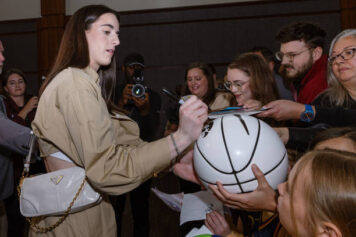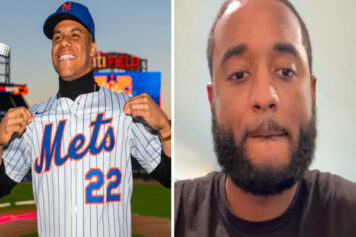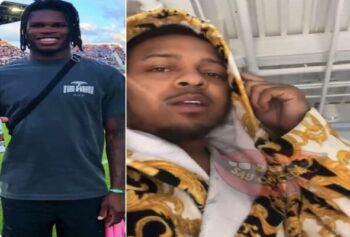“If you build it, they will come”
There are two black perspectives on baseball in America. There are the 35-and-older diehards whom grew up when baseball was that sport and MLB rosters sported an all-time high, 19 percent African-American players, like in 1995. When posters of Willie Mays, Ken Griffey Jr., Darryl Strawberry, Barry Bonds, Tony Gwynn and Ricky Henderson graced the bedroom walls of African-American kids, next to the posters of Walter Payton and Dr. J.
According to an April 2013 Forbes article, a Gallup Poll in 2003 found the percentage of African-Americans referring to baseball as a favorite sport to watch dipped from 43 percent in 1960 to 5 percent now.
Out of this decline emerged the 30-and-under cats, who shun baseball like a plague or an illegitimate cousin with no real connection to anybody at the dinner table.
The fact that blacks have gone cold on baseball is an old scoop, with brothers now blessing just 8.5 percent of MLB rosters.
It’s a sport that’s increasingly seen as a rags-to-riches lick for Hispanics—the game’s fastest growing ethnic group—and a normal part of the master plan for white athletes.
The common question from the black baseball bashers is, “Where are all the black players?” The diehards often ask, “What are we going to do about it?”
The remaining loyalists are the parents that become little league coaches, with visions of their sons becoming the next Andre Dawson, or at least getting a chance to play against the best 12 to 13-year-old’s in the world in the crown jewel of youth tournaments, The Little League Baseball World Series which has set up it’s customary shop in Williamsport, Penn. until August 25th.
The low number of African-Americans playing in the LLWS coincides with the overall absence of black faces on the pro diamond. Most of these kids get their “Baseball Jones” from baseball lifers that are on the front-line, coaching any athletic kid they can find and keeping the spirit of baseball alive in the African-American community, however faint.
**********
MLB’s Reviving Baseball In Inner Cities (RBI) program and the burgeoning Urban Youth Academies have been supporting inner-city baseball organizations in attacking the problem at the core, and remedying it, since 1989.
The RBI program is a baseball extinction prevention and recovery device that swoops in and offers baseball and softball to youth ages 5 to 18 in underserved African-American communities, with an initial intention of helping more of them gain college scholarships.
RBI Program Director David James told The Shadow League that, in the past 25 years, the programs had “1,000,000 kids, with over 150 of them being drafted by MLB teams.”
James says “99 percent of the RBI participants won’t become major leaguers,” but if it keeps increasing its current average of about two pro players a year, over time that adds up.
Breeding new stars begins with infiltrating the MLB Draft. In recent years, RBI programs and UYA’s have been doing that, with hundreds of players with ties to one of the four UYA facilities being selected over the last eight years.
“There’s an upswing [in attendance and draft presence] right now,” said James, who became the first full-time director of RBI baseball in 2008. Since James became the soul-controller, he instituted the Jr. RBI program for shorties, ages 5 to 12 and the number of yearly participants has doubled from 120,000 to over 200,000 in 2013.
The 2013 MLB player draft was held in June, and “a record-16 RBI alum’s were drafted, including two first-rounders,” James boasted, before adding that the amount more than tripled the number of players selected in the 2011 draft (five).
Slick-fielding shortstop JP Crawford and power-hitting first baseman Dominic Smith were first-round selections and represent the next wave of African-American talent with ties to MLB’s RBI program and Compton’s Urban Youth Academy. Both players won the junior division championship with the Venice Boys and Girls Club in the 2009 RBI World Series.
Crawford, cousin of Dodgers outfielder Carl Crawford was the 16th overall pick by the Philadelphia Phillies. The 6-2, 180-pound Lakewood (Calif.) HS stud ranked 19th on MLB.com’s Top 100 Draft Prospects list.
In fact, 11 percent of the players on that list are brothers. With RBI products comprising at least 20 percent of those top black players, it’s safe to say the program’s making an “acorn crashing down on your car roof” dent in the concept of MLB’s ever diminishing black appeal. Those minor dents tend to expand and become more visible as time goes on.
Smith, 18, was drafted 11th overall by the NY Mets out of Junipero Serra High School, also in Kushtown. MLB Network analyst Harold Reynolds calls the power-hitting Smith “the best left-handed bat in the Mets organization since Darryl Strawberry.”
That’s high praise for a kid fresh out of puberty, but pro baseball is starving for more charismatic black superheroes like Deion Sanders and Bo Jackson, and you have to start somewhere.
The RBI and UYA programs function as extensions of each other. RBI baseball nurtures a player from novice levels, pits them against some wicked comp, and further develops their skills through the availability of a more personal and professionally-geared UYA facility.
Crawford and Smith, not coincidentally, are two Cali cats, just like 1990s black baseball kings Strawberry and Eric Davis, who both grew up in Southern California and were the first “stars” to embrace the project, donating their time, along with money for bats, balls and uniforms for the kids to use.
“We played baseball and Little League out in Compton and all the parks in the area,” Strawberry, a two-time World Series champ, told MLB.com in 2008. “We wanted to give back to the inner city for the kids… to understand that baseball is the greatest game in the world and they can have an opportunity to play it.”
When John Young first got his RBI program off the ground, he noticed fewer African-American ballplayers coming out of Los Angeles, which had been a hotbed for ballplayers since the late 1950s. His plan was to increase the SoCal talent pool. Initially, pickings were slim, with just 11 L.A. kids showing up for the first tryout, but with the support of these elite black major leaguers, Young had 180 ball-tossing (not C-Walking) kids by opening day.
“It was something that we needed to do,” said Young, a former Major League player and scout, in the same 2008 MLB.com article. “When you have people like that behind you, other people listen.”
Their proposal was sent to former Major League GM Roland Hemond, who helped put it in motion.
Decades later, the program’s contributed to at least making baseball a viable option for inner-city youth in its 290 leagues spread across 200 cities and five countries. A growing list of dope MLB players say the RBI program put the baseball-battery in their backs.
African-American cleat-brawlers, like “Coco” Crisp, Jimmy Rollins, CC Sabathia, The Uptons, James McDonald and Dontrelle Willis are among the more than 40 current and former Major League and Minor League players who have taken part in the program, which has expanded over the years to not only include baseball but girls softball as well, with 16 RBI grads currently playing college softball.
**********
Sabathia and a slew of other MLB players are striving to make baseball more tangible and enjoyable for black kids in those urban battle grounds, whose entire athletic existence is limited to a crooked jump shot and the risk of concussions.
“They work with local leagues in their club markets,” James told TSL, “and we utilize those guys to participate in clinics. A number of them have supported a local league by potentially donating money for a field or donating equipment and uniforms.”
Carl Crawford grew up humbly in Houston as a heavy basketball and football dude, but playing in the 1997 RBI World Series, “gave me the confidence I really could play baseball,” Crawford told usatoday.com in ‘11. “RBI gave me a chance to measure myself with players from across the country.”
Crawford was drafted by the Tampa Bay Rays in the second round of the 1999 draft out of Houston’s Jefferson Davis High School.
Diamondbacks outfielder Chris Young, Dodgers first baseman James Loney, Astros outfielder Jason Bourgeois and Cleveland’s Michael Bourn are also products of Houston’s RBI program.
It would be a desperate enthusiasts’ pipedream to suggest the brigade is coming, but there are a lot of fresh faces flashing gloves and swiping bags in the streets of Crenshaw and Harlem.
Let’s be honest: expecting a mass exodus of top black athlete’s to start chucking aside their Air Jordan’s for some cleats is as unlikely as Tupac’s resurrection. The success of these grass roots programs have to be followed up by a national marketing approach that gets African-American kids without access to RBI programs hyped about baseball, too.
Darryl Grisby, baseball historian and author of the book “Celebrating Ourselves: African-Americans and the Promise of Baseball,” told TSL, “The RBI programs are working. There’s a fair number of black ballplayers coming out of the south, which I list in my book by position, with 10 to 15 percent 0f top prospects in the minors being African-American. The potential is there, guys just have to start breaking through.”
**********
After years in Puerto Rico, the UYA finally stopped neglecting the inner-cities and came to Compton in 2006. Now, new facilities have opened in Houston and New Orleans and there are academies under construction in Cincinnati, Philadelphia, South Florida and Washington D.C.
“You already know facilities and finances are a challenge to urban communities,” Negro League Museum President Bob Kendricks told TSL.
“These types of academies and programs inspire a love for the sport and make it convenient to participate”
The P&G Cincinnati MLB Urban Youth Academy is currently being constructed about nine miles from the Great American Ball Park, at Roselawn Park, where representatives of the Reds and MLB broke ground in July. The $5.5 million baseball heaven is the first in the Midwest, and will offer free year-round instruction to the area’s youth and includes four newly renovated outdoor baseball and softball fields and a 33,000-square-foot indoor facility that will hold batting cages, pitching tunnels and another field. All things that are huge for any inner-city, cash-strapped community.
“I think kids here want to play baseball,” said UYA director Darrell Miller at the groundbreaking ceremony. “But they just need a little bit more help getting the resources and knowing how to play.”
The RBI program’s attendance suggests a flicker of baseball hope for the black community. Phase two is increasing the pipeline of little league coaches in inner-cities to keep the first-rounders coming. More young cats need to be coaching and spreading that baseball love to even younger cats moving forward.
Some dudes will always think baseball’s as offensively slow and unappealing as Rick Ross in some skinny jeans, but there’s evidence to suggest that the “black” style of play—a faster-tempo game emphasizing athleticism, speed, flair and defense—is re-emerging as the steroids era dissipates.
The fight to save black baseball exists and begins on the choppy, grass fields of community parks and the worn out garage doors that serve as catchers mitts for aspiring hurlers. It’s just as real as the lack of love many brothers show the sport.
Counting pros can’t be the only barometer for measuring inroads. There are positive examples of grassroots-level success that hints at change. Over the years, baseball has become more community oriented, a niche sport that is passed down from generation to generation.
We need more soldiers like Joseph and son William Haley, who over the past 20 years have turned Jackie Robinson West Little League, a team of African-American youths from Chicago’s Southside, into perennial LLWS contenders.
Stories like theirs are proof that black baseball still has a pulse. The voice that spoke to Kevin Costner in the movie Field of Dreams, must have also been talking about programs like RBI when it said, “If you build it. They will come.”



